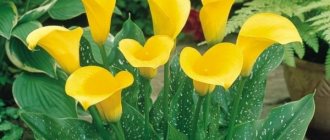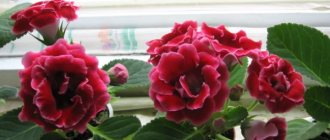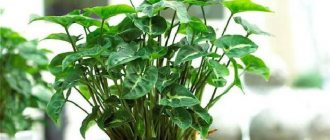Since ancient times, delicate, colorful, daisy-like gerberas have been the personification of joy and lightness, becoming guardians of love and fidelity. So, having settled a bush of bright flowers in your home, expect changes for the better. A nice bonus is that the plant is unpretentious. And even if this is your first experience of growing indoor gerberas, don’t worry, caring for the plant will not take much time and effort. The main thing is to take the trouble to understand the basic needs of your exotic guest and create the most “native” microclimate for her.
Briefly about care
| Type of agricultural operation for caring for gerbera | Description of conditions and actions |
| Watering and air humidity | During the period of intensive growth and flowering, water twice a week (after the top layer of soil has dried) with soft, moderately warm water in autumn and winter, reduce the number of waterings to 1-2 times a month, it is better to water from a watering can with a narrow spout along the edge of the pot so that moisture does not fell on a leaf rosette, the plant needs high humidity up to 70% |
| Lighting organization | Daylight hours are at least 12 hours (in the autumn-winter period additional lighting with phytolamps is required); loves a lot of bright light, but in extreme heat it is better to shade it from aggressive ultraviolet radiation |
| Maintaining a rest period | From mid-November to second half of February |
| Creating temperature conditions | In spring-summer 20-24 ºС in winter 14-16 ºС; during the flowering period, do not allow sudden temperature changes, do not allow the air to cool below 19 ºС |
| Trimming | Only during reproduction |
| Making soil mixture | Well-permeable, slightly acidic loose soil made of leaf soil, peat and sand (2:1:1); you can add a little pine bark |
| Fertilizer application | Once every one to two weeks, when watering, use complex fertilizers for flowering plants:; During intensive growth and summer, gerbera requires nitrogen; flowering bushes should be fed with potassium; flowers growing in a cool room should be additionally fed with phosphorus; to prepare the solution, use a halved concentration of mineral fertilizers |
| Transfer | Every year with the arrival of spring, as soon as young greenery appears |
| Chemical treatment | Insecticides: whitefly, aphids, spider mites, scale insects, mealybugs; fungicides: mold, powdery mildew, late blight, gray rot, chlorosis |
Gerbera care
Gerbera is quite unpretentious in everyday conditions, but it needs a lot of light and a comfortable temperature regime. And be sure to regularly monitor humidity and its effect on the flower. Otherwise, if you maintain suitable conditions, gerbera does not cause any trouble.
Temperature
Ideal conditions during the active season are about 20-24 degrees Celsius. In winter, when the flower rests alone, it is enough to maintain 12-14 degrees. But make sure that the thermometer mark does not fall down, and avoid sudden changes from day to night. Otherwise, beautiful large basket flowers will lose their shape and decorative properties.
Photo: distano.ru
Lighting
Gerbera needs a lot of bright, but diffused light, so much so that during the season of active growth it often needs to be supplemented with lamps. In summer, be sure to shade the bush if it grows on the south side. The amount of light during the day directly affects the flowering and decorative properties of gerberas.
You can take the flowerpots outside, but accustom them to new conditions slowly, gradually extending the period of “walking”. If you plan to seriously engage in breeding, get a fluorescent lamp in advance for the fall.
Photo: syngenta.ru
Watering
Gerbera is watered with strictly warm water at moderate intervals. The guest from drought-prone regions was not used to large amounts of moisture. Moisten the substrate when it is completely dry from above, but under no circumstances flood the stem and leaves.
You cannot spray the rosette and petals of the gerbera, because this will cause it to rot. To ensure high humidity, place a bowl of water next to it or fill a tray with moistened expanded clay. In winter, this is not necessary, nor is regular watering - just make sure that the soil does not dry out completely.
Photo: goodfon.ru
The soil
The gerbera root must breathe, so the soil must first be loose. At the same time, thanks to this, water will not stagnate, because of which the root and beginning of the stem will rot. Take a mixture for any Asteraceae or combine leaf soil, sand and peat in equal amounts.
Photo: healthyfoodhouse.com
Fertilizers and fertilizing
Gerbera needs to be fed only when it is growing rapidly and is about to bloom. As in the case of soil, ready-made mineral mixtures for flowers are suitable, but periodically add magnesium sulfate. During cold spells or short-term frosts, be sure to add phosphorus.
Photo: yellowhome.ru
Transplantation and propagation
There is no need to constantly replant your gerbera, so carry out the procedure only as it grows and is necessary. You need very high-quality drainage so that all excess water drains through it. You cannot immerse a leafy rosette in the ground - it should not be exposed to any form of soil at all.
Gerbera is sprouted from seeds, but then you will need fertile soil with turf and humus. Seedlings dive when they have the first 2-3 full-fledged leaves, and then again at the 5-6th leaf. For the second picking, you can already take separate pots.
The most convenient way to propagate gerberas is by division, especially if it is a decorative variety. This is the only way to fully preserve all the characteristics of the parent plant. Choose a large bush at least three years old, divide it in the spring and so that several sprouts diverge from each share.
Photo: floraved.net
Dracaena (70 photos): types and features of care
Description of the plant
Gerbera (lat. Gerbera) is a long-lived herbaceous plant from the Asteraceae/Asteraceae family. At the moment, more than 80 species of gerberas grow in different parts of the world. Beautifully flowering ornamental plants are grown on an industrial scale - for cutting, in garden plots and as potted crops. In its natural habitat, the exotic plant is found in South Africa, India, China and Madagascar.
In nature, gerberas reach impressive sizes. Large baskets of flowers look like garden chamomile, painted in warm, rich shades. If there are double flowers, from a distance they resemble large asters. According to their shape, all gerberas can be divided into four groups:
- Single flowers. Gerberas with a row of non-overlapping petals and a green disk core.
- Duplex. Plants with a double row of overlapping petals and a black, green or dark red heart.
- Crested. Of interest are two rows of overlapping petals with one or more inner rows of shorter petals. The core is scarlet or black.
- Double Crested. Gerberas with continuous overlapping rows of petals, the size of which decreases towards the center, covering it.
The home (indoor) gerbera is intended for growing in an apartment, characterized by its compact volume and height of about 30 cm. Indoor varieties have a lot of differences: different shapes of inflorescences, colors, etc. However, the main characteristics of the bright representatives of the Asteraceae are unchanged. Do you want to know what gerbera flowers look like and recognize them at first sight? So, be sure to understand the following:
| Characteristic | External signs |
| Stem | Low single elastic peduncle |
| Leaves | Delicate green, large, pinnately dissected with notches at the edges, collected in a basal rosette |
| Flowers | Large colorful baskets 5 cm in diameter; petals are double, semi-double or single, painted in all rainbow shades except blue; the core is yellow or dark |
| Root system | The rhizome is solid, formed by numerous cord-like roots |
Especially often in indoor floriculture, mini-bushes with peduncles no higher than 30 cm or a mix are grown - compositions of gerberas of different colors, planted in one pot.
Popular varieties of indoor gerberas
It is almost impossible to find natural species of tropical plants at home. If your gerbera is growing in a flower pot, it is most likely a hybrid variety, specially bred for indoor growing. By crossing Jameson's gerbera with more resistant varieties, breeders have developed many hybrids that differ in size, shape and color. They can be classified as follows:
| Group | Distinctive features |
| Small-flowered with narrow petals | The diameter of the inflorescence is up to 9-10 cm, the peduncle is 50 cm; a popular representative is the gerbera “Aldebaran” |
| Large-flowered with narrow petals | Inflorescence 9-13 cm, peduncle up to 70 cm common: gerberas with rich yellow flowers “Jupiter”, powdery “Migar” |
| Large-flowered with medium petals | The diameter of the inflorescence is 11-13 cm, the peduncle is up to 70 cm; the best seller is the blood-red “Mars” |
| Large-flowered with wide petals | Inflorescence 10-15 cm, peduncle up to 60 cm, red varieties of gerbera are popular: “Romeo”, “Delios” pink “Vera”, yellow-orange “Saturn” |
| Semi-double and double with narrow petals | The diameter of the inflorescence is up to 11 cm, the height of the peduncle is up to 50 cm, especially in demand in indoor floriculture: gerberas with pink flowers “Viola”, yellow “Kalinka”, juicy red “Sonya” |
| Semi-double and double with wide petals | Flower 11-14 cm, peduncle height up to 70 cm The most popular variety is “Spark” |
Beneficial features
Gerberas are colorful flowers with a delicate aroma that, at home, will not harm even allergy sufferers or asthmatics. This flower serves as a natural air purifier, filtering oxygen from harmful impurities. In addition, a useful property of gerbera is its ability to maintain a blooming decorative appearance for about a month.
Competent care
In order for indoor gerbera to develop normally at home, immediately after purchase, provide it with proper care and create a suitable microclimate. Proper watering and humidity in the room where Transvaal chamomile grows plays a very important role. If there is an excess of liquid, the plant will begin to rot; if there is too little, it will begin to dry out. Too dry air is destructive, but spraying gerbera can lead to many troubles. What is the best way to water a gerbera:
- along the edge of the pot so that drops of water do not fall on the above-ground part of the plant;
- through a tray of water, immersing the pot in it for 20-30 minutes.
Attention! Watering with too cold water can cause plant diseases, and waterlogging the soil can lead to the development of nematodes (small worms that are very difficult to remove).
During the heating season or in the summer, when the air in the apartment dries out, tropical inhabitants have a hard time. The method used for other plants is not suitable here - spraying with a spray bottle will lead to rotting of the leaf rosette and the death of the entire flower. And yet, in order for the plants not to wither, they need to be provided with sufficient moisture. This will help you:
- household humidifier;
- wet expanded clay (place it in a tray and place a flower pot on it);
- spraying water in the room (at a safe distance from the plant);
- indoor decorative fountain;
- aquarium.
To prevent your gerbera from needing treatment, protect it from disease and pests with prevention. Spray with pesticides from time to time, do not forget to disinfect the substrate. Also note the following:
- Stuffiness and excessive air humidity can lead to the development of fungi.
- If you get carried away with watering, the plant will rot.
- If you treat the leaves with alcohol-containing products, you will cause burns.
- Place the indoor relative of the Jemson gerbera in a sunny window - the leaves will turn pale.
- If you do not provide sufficient lighting, the plant will begin to stretch and lose its decorative properties.
Diseases and pests
Let's look at the causes of the most common plant diseases:
- dark spots on gerbera leaves indicate the appearance of a fungal disease;
- leaves turn brown when infected with late blight, which occurs when the substrate is too dense and abundant watering;
- white mold on the leaves is nothing more than powdery mildew or physarium - a type of fungus;
- the interveinal space of the leaves turns yellow due to chlorosis, a pathology caused by a lack of iron;
- leaves turn black in a room with high humidity, as well as with abundant watering with cold water.
- the edges of the leaves dry out when the flower is not sufficiently moistened, or when there is an excess of fertilizing components;
- Roots rot due to too frequent and abundant watering.
- does not bloom in conditions of constant lack of sunlight, as well as in the absence of a dormant period in the cold season.
Other gerbera diseases can be caused by pests - mealyworms, spider mites or whiteflies.
Reproduction methods
Transvaal chamomile is propagated in four ways:
- Dividing the bush. The method is applicable for plants three years old and older. In spring, the flower, which has grown to two or more leaf baskets, is divided into parts, on each of which at least 3 growth buds remain. After 6 months, the children begin to grow rhizomes.
- Rhizome. A fragment of the rhizome with part of the leaves is separated from the mother plant and transplanted into moist soil.
- Seedlings from seeds. Sowing in a mini-greenhouse with a loose airy substrate, after the first three leaves appear, the first picking is carried out, after the appearance of 5 leaves - planting for permanent residence. The planting material is not dusty, like petunias, but rather large, so sowing it is easy and simple. Simply stick the seeds with the sharp end into the moistened substrate and lightly crush them on top.
- By cuttings. From a plant that is not yet 3 years old, a part of the stem with a leaf and a node is cut off. The cutting is placed under a film in a moist substrate. After a week (when new shoots appear), the gerberas need to be transplanted into pots and provided with proper care.
Reproduction
White gerbera is propagated in three ways:
- seeds;
- dividing the bush;
- cuttings.
IMPORTANT! If you choose the first method, plant the seed in early spring. It should only be lightly covered with a small layer of soil. You will be able to see the first shoots within a couple of weeks. But the plant will please you with flowering only after 10 months.
Only an adult bush needs to be divided. To do this, choose flowers that have reached the age of 3-4 years. For this procedure, you will need a sterilized sharp knife to separate the rhizomes. Your reference point should be your kidneys. The part that is not subject to stress will be ready for a full transplant in 15 days. She will inform you about her readiness with young shoots. It is necessary to plant sprouts at a distance of 30-40 centimeters from each other. This propagation method is the most popular among professional gardeners.
To make gerbera cuttings, cut pieces with 1-2 leaves from the roots . Greenery is reduced by about 30% by pruning it. The cuttings are planted in moist soil and kept at a temperature of 23 degrees Celsius and above.
When caring for “snow white”, follow all recommendations. And then growing this flower will turn into pleasure.
Possible problems
Illiterate care, pest invasion or mechanical damage can lead to the death of the plant. It is important not to miss the first symptoms of the disease and to take appropriate measures. Flower growers especially often encounter yellowing of gerbera leaves, which occurs for the following reasons:
- The plant has reached a critical age (the lower leaves turn yellow and fall off).
- Excessive soil moisture (leads to yellowing of the entire leaf rosette).
- The flower stands in a cold draft, near the air conditioner, in front of the fan (the foliage of the tropical plant turns yellow and falls off).
- Too little light (yellowing begins with leaves located in the shade).
- Depleted soil, acute lack of nitrogen fertilizers (the veins are dark and the surrounding tissues have turned yellow).
- Infection with a virus (yellowishness in the form of spots, deformation of stems, pale flowers, but no completely dried areas).
If the gerbera withers and stops growing, it’s time to reconsider the watering regime. Here, the soil is equally likely to dry out or become waterlogged. In the first case, water the plant through a tray. In the second, remove it from the pot along with a lump of earth, wrap the lump in a rag to remove excess moisture, place it in the pot and adjust the watering.
If brownish spots appear on the leaves, they must be cut off and the above-ground part treated with a fungicidal solution.
Gerbera color: symbols and meanings
There is an opinion that gerberas are given exclusively to men. But as practice shows, a simple and elegant flower is quite universal. Not a single floral mix is complete without a bright beauty, and a potted plant becomes a truly royal gift for both sexes. Surround the gifted plant with care, and it will bring prosperity, an optimistic mood, and quiet joy into your home.
When acting as a gift giver, first learn the meaning of each gerbera color. This way you will talk about your feelings and won’t get into trouble (who knows, maybe the hero of the day is well versed in the symbolism of flowers).
Reds
In the language of flowers, purple, blood-red and scarlet gerberas mean peace of mind and joy. For women, any shade of red is suitable. The male version is dark burgundy shades of the petals. You can give them if you want to confess your tender feelings and willingness to carry them throughout your life. To confess your ardent passion, it is better to choose other flowers.
Yellow
Do you want your home to be filled with laughter and a feeling of celebration? So, pay attention to flowers with yellow or orange petals. By choosing these flowers as a gift, you wish the person good luck and many joyful moments.
Pink
They personify tenderness, airiness, purity. Better than any words, they will tell about your admiration and sympathy. It is better to give them to very young girls.
White
Florists call these gerberas wedding gerberas, because the meaning of the flower is innocence and purity. White flowers are used to decorate weddings and bridal bouquets.
Cream
Do you want to tell a loved one about your care and caring attitude? So, give him a cream flower. This gerbera is not for strangers.
Now you know what this or that gerbera color symbolizes and you can give not just beautiful, but also suitable flowers. By giving a bouquet, you will bring joy to a person; by presenting a potted plant, you will bring prosperity to his home.
Gerbera – photo
The beauty and effectiveness of gerberas is not a myth, but an actual reality! Check out the photo to see how different and colorful it is!
Photo: pxhere.com
Photo: mioverde.ru
Photo: yellowhome.ru
Photo: oir.mobi
Photo: u-mama.ru
Photo: oir.mobi
Photo: pinterest.com
Photo: m.ok.ru
Photo: oir.mobi
Photo: mykaleidoscope.ru
Photo: oir.mobi
Photo: floraved.net
Photo: domashniecvety.ru
Photo: floraved.net
Photo: irecommend.ru
Photo: mkdou19.ru
Photo: ok.ru
Photo: funonnetgallery.blogspot.com
Photo: oir.mobi
Photo: oir.mobi
Photo: oir.mobi
Photo: mykaleidoscope.ru
Photo: mykaleidoscope.ru
Photo: domashniecvety.ru
Photo: mykaleidoscope.ru
Photo: mykaleidoscope.ru
Photo: mvazonchik.ru
Coleus (60 photos): types and features of care
"Hot" questions
Even if you know how to care for potted gerbera, force majeure is unlikely to be avoided. Either the leaves will turn yellow, then flowering will stop prematurely, then just yesterday the flowers given to you will unexpectedly fall off, etc. Fortunately, Internet resources are full of useful tips and reviews that allow you to find a way out of any situation. To save your time, we have collected the most pressing questions here.
How long do gerberas last in water?
Freshly cut flowers retain their presentable appearance for up to 20 days. Store-bought ones can last up to two weeks (depending on transportation conditions and the freshness of the bouquet). To preserve your plants for as long as possible, use the following recommendations:
- Using a sharp knife or razor, cut a 3-centimeter piece of the stem diagonally under running cold water;
- covering the cut site with your finger, place the stem in a narrow vase so that the shoots “drown” in the water by about 5 cm, and the stems do not touch the bottom (an improvised frame made of wire or fishing line will help with this);
- place the vase away from bright sun, heaters and drafts;
- the room in which the bouquet stands should be shady and cool (10-18C);
- In the hot summer, spray the flowers with a spray bottle with cold water twice a day.
It happens that the midday sun manages to burn the delicate petals and timely help can save the plant from death. A cut gerbera can be revived almost like a person suffering from heatstroke. After placing the bouquet in a vase, cover it with a damp paper cap and place it in a cool place.
Advice! Feel free to shorten the stems every day and remember - the shorter the “leg”, the longer the flowers will remain fresh.
Are gerberas annual or perennial flowers?
Both garden and indoor plants are perennials. But specimens growing in open ground should be hidden from frost. Some gardeners do not do this, sincerely considering the luxurious flower an annual.
What kind of water can you put gerberas in?
You will significantly increase the lifespan of flowers by placing them in settled water at room temperature. The ideal option is rain or melt water, but if this is not available, tap water will do. Let it stand in the room for 5 hours and only then place the bouquet in it.
To extend the life of the bouquet, choose any of the following options:
- for 1 liter of water 1 teaspoon of citric acid or 5 tablets of activated carbon;
- slightly pink solution of potassium permanganate;
- store-bought fertilizers for fresh-cut flowers: “Bona Forte”, “Living Bouquet”, etc.
Attention! Do not add sugar to the water with gerberas if you do not want them to wilt quickly.
In order not to ask why the flowers of a recently gifted gerbera suddenly drooped, remember: the flowers should not come into contact with absolutely anything. Do not lean the bouquet against the wall, do not press the stems to the bottom of the vase, or leave the plants in the wrapper. A slight crease on a petal is enough to ruin the bouquet.
Appearance and features
Externally, gerberas are very reminiscent of daisies, only the colors of the former are more varied. In our case, even the shades of the basket flowers are practically the same. The peduncle on the plant is always single, surrounded only by leaves attached to the shoots. A feature of the described flower is its heat-loving nature. Therefore, it usually reproduces in greenhouses, conservatories or in a warm house.
The types of gerberas that bloom in pink, red, yellow and orange look very beautiful. You can make a magnificent bouquet from them and give it to your loved one.











